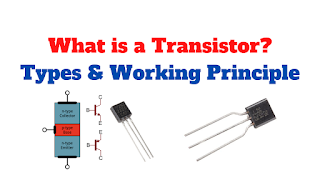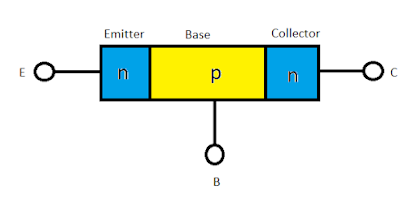
What is a Transistor?
A
Transistor is a three terminal device : Base, Emitter and Collector can be
operated in three configurations such as common base, common emitter and common
collector.
According to
configuration it can be used for voltage as well as current amplification.
The
amplification in the transistor is achieved by passing input current signal
from a region of low resistance to a region of high resistance. This concept of
transfer of resistance has given the name TRANSfer-resISTOR (TRANSISTOR)
Types of
Transistors :
There are
two types of transistors : Unipolar junction transistor and Bipolar junction
transistor.
In unipolar
transistor, the current conduction is only due to one type of charge carriers,
majority carriers.
The current
conduction in bipolar transistor is because of both the types of charge
carriers, holes and electrons. Hence this is called Bipolar Junction
Transistor, hereafter referred to as BJT.
Types of
BJT :
1. 1. n-p-n type 2. p-n-p type
Advantages of
BJT :
L 1. Low operating voltage
2 2. Higher efficiency
3. 3. Small size and ruggedness
4. 4. Does not require any filament power
Structure of pnp and npn transistors :
When a transistor is formed by sandwiching a single p-region between two n-regions, as shown in the below figure, it is an n-p-n transistor. The p-n-p type transistor has a single n-region between two p-regions, as shown in the below figure.
(a) n-p-n transistor
(b) p-n-p transistor
The middle region of each transistor type is called the base of the transistor. This region is very thin and lightly doped.
The process by which impurities are added to a pure semiconductor is called doping.
The remaining two regions are called emitter and collector.
The emitter and collector are heavily doped. But the doping level in emitter is slightly greater than that of collector.
The collector region-area is slightly more than that of emitter. It helps in better power dissipation.
Transistor Symbols :
The below two figures shows the symbols of npn and pnp transistors.
(a) n-p-n transistor symbol
(b) p-n-p transistor symbol
Arrowhead on a transistor symbol indicates the conventional current which is opposite to the direction of electron current in emitter.
Diode equivalent structure of Transistor :
A Transistor can be considered as two p-n junction diodes connected back to back shown in the below figures.
(a) n-p-n transistor
(b) p-n-p transistor
Junctions of Transistor :
A transistor has two p-n junctions.
One Junction is between emitter and the base is called the emitter-base junction or simply the emitter junction JE
The other junction is between the base and the collector and is called collector-base junction or simply collector junction JC
Cannot replace transistor by back to back diodes :
However, we cannot replace transistor by back to back diodes because of the following reasons:
Relative doping levels in the base, emitter and collector junctions must be satisfied to work that device as a transistor. Two normal p-n junction diodes cannot satisfy this requirement.
In a transistor, emitter to base junction is forward biased while base to collector junction is reverse biased. But due to diffusion process almost entire emitter current reaches to collector and base current is negligibly small.
Thus due to diffusion, device works as a transistor. While in back to back connected diodes there are two separate diodes, one forward biased and one reverse biased and diffusion cannot take place. Thus maximum series current which can flow is reverse saturation current of a reverse biased diode.
Another important point is that, the emitter area in the transistor is considerably smaller than the collector area. This is because the collector region has to handle more power than the emitter and more surface area is required for heat dissipation.
<script data-ad-client="ca-pub-6336795697425578" async src="https://pagead2.googlesyndication.com/pagead/js/adsbygoogle.js"></script>















No comments